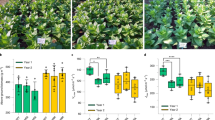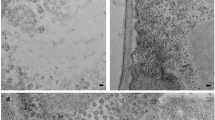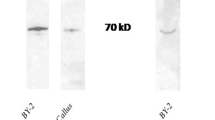Abstract
BECAUSE of its waxy cuticle, plant leaf tissue admits few substances applied to the leaf surface. Biochemical studies on the effects of exogenous additives on cell metabolism may require such substances to enter the cells with a minimum delay between application and absorption. Work in this laboratory on the multiplication of tobacco mosaic virus in tobacco leaf tissue has prompted the development of a technique for the preparation of quantities of isolated tobacco leaf cells. These cells support virus multiplication and overcome the barrier to penetration of low molecular weight substances, presented either by the intact leaf or the detached leaf or leaf piece.
This is a preview of subscription content, access via your institution
Access options
Subscribe to this journal
Receive 51 print issues and online access
$199.00 per year
only $3.90 per issue
Buy this article
- Purchase on Springer Link
- Instant access to full article PDF
Prices may be subject to local taxes which are calculated during checkout
Similar content being viewed by others
References
Chayen, J., Nature, 170, 1070 (1952).
Stephenson, M. L., Thimann, K. V., and Zamecnik, P. C., Arch. Biochem. Biophys., 65, 194 (1956).
Boardman, N. K., and Zaitlin, M., Virology, 6, 758 (1958).
Author information
Authors and Affiliations
Rights and permissions
About this article
Cite this article
ZAITLIN, M. Isolation of Tobacco Leaf Cells Capable of Supporting Virus Multiplication. Nature 184, 1002–1003 (1959). https://doi.org/10.1038/1841002a0
Issue Date:
DOI: https://doi.org/10.1038/1841002a0
This article is cited by
-
Isolation of intact mesophyll cells from the leaves of higher plants
Proceedings / Indian Academy of Sciences (1979)
-
Studies on the mucilaginous layer of barley (Hordeum vulgare) roots
Plant and Soil (1977)
-
Foliar absorption — penetration of the cuticular membrane and nutrient uptake by isolated leaf cells
Qualitas Plantarum et Materiae Vegetabiles (1967)
-
Ion Uptake and Protein Synthesis in Enzymatically Isolated Plant Cells
Nature (1965)
-
Removal of Apple Leaf Cuticle by Pectinase to reveal the Mycelium of Venturia inaequalis (Cooke) Wint.
Nature (1962)
Comments
By submitting a comment you agree to abide by our Terms and Community Guidelines. If you find something abusive or that does not comply with our terms or guidelines please flag it as inappropriate.



